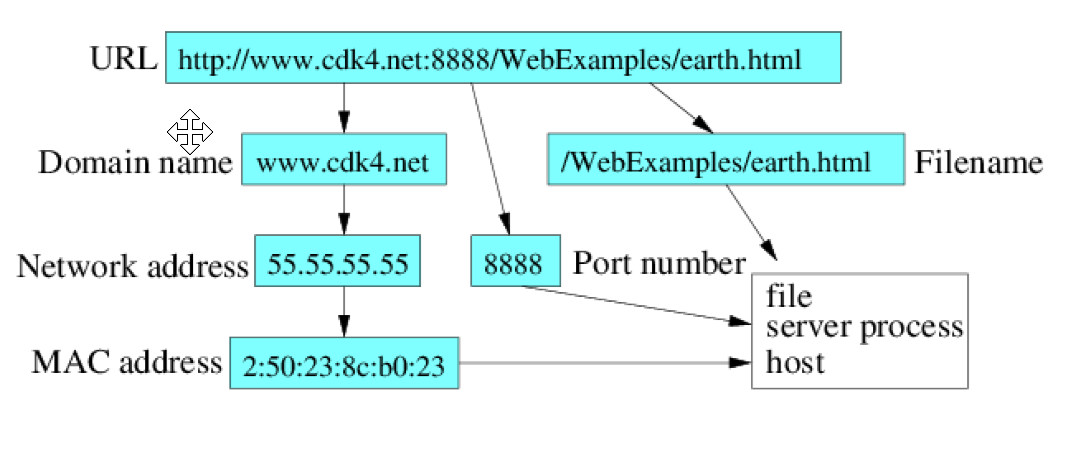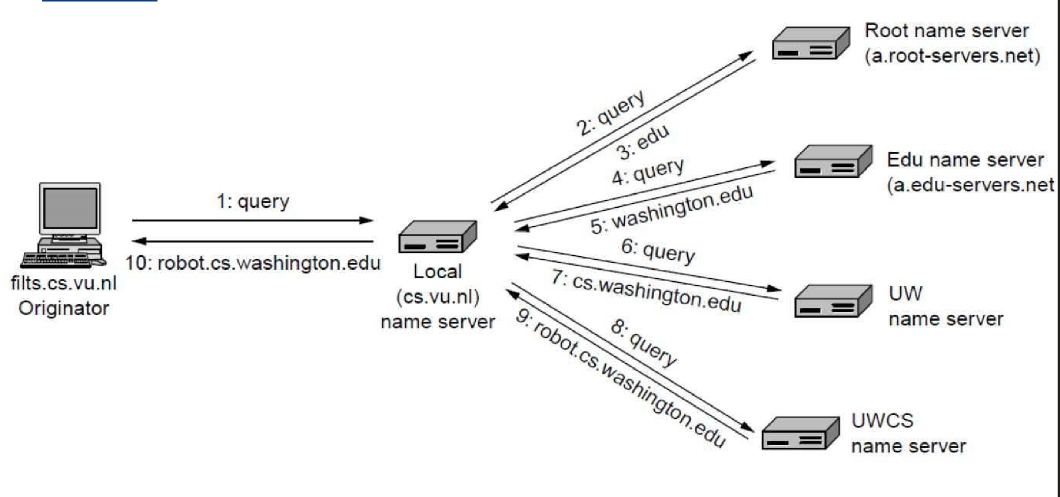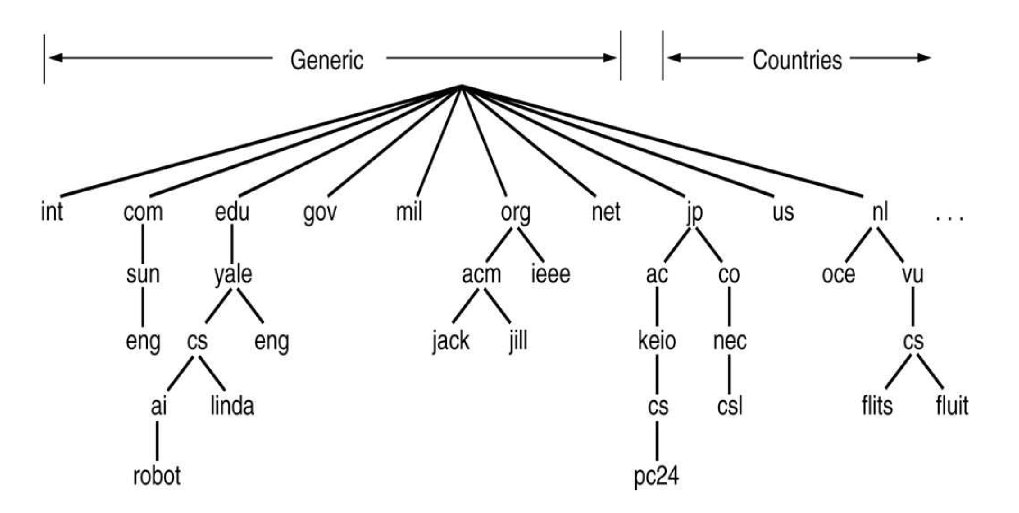Distributed Systems
Name Services
Name Services
Overview
- name services are used by client processes to obtain resource attributes given their names
- resource: e.g. file
- attribute: e.g. attribute
- directory services: look up services when given some of their attributes
- name spaces: structure and management
- implementation of name services
Names and Addresses
- names: used to refer to shared resource
- computers
- services
- remote objects
- files
- users
- names are needed to request a computer system act on a specific, chosen resource
- processes need to be able to name resources to share them
- users need to be able to name each other to directly communicate
- sometimes descriptive attributes of a resource uniquely identify it
- human-readable names: e.g.
/etc/passwd,http://www.registermachine.com - identifier: not usually human-readable, e.g. remote object references, NFS file handles
- more efficiently stored and processed by software
-
attribute: value of a property associated with an object
- address: value identifying the location of the object, rather than the object itself
- attribute of an object
- efficient for accessing objects
- cannot be used as a name, because the object may change its address
- pure name: contains no information about the object itself.
- Must be looked up to obtain an address before the named resource can be accessed
- e.g. names of people are pure names
- uninterpreted bit patterns
- address is the opposite extreme
-
non-pure name contains some information about the object, typically location information
- a name is resolved when it is translated to data about the named resource
- binding: association between a name and an object
- names are bound to object attributes, rather than the objects themselves
- DNS maps human readable domain names to IP addresses/other attributes
- X500 directory service: can map a person’s name onto attributes e.g. email address, phone number

- local significance: many names only have meaning to the service that creates it
- when a service allocates a resource it generates a unique name, and a client to the service needs to supply the name in order to access that resource
- sometimes the client can specify to the service the desired name for a new resource
- e.g. email username they would like
- service is responsible for ensuring username is locally unique
- then, in combination with unique domain name, the email address is unique
- services may need to cooperate to have name consistency
- e.g. NFS users need the same unique ID on both the client and server to ensure ownership rights are preserved
Uniform Resource Identifiers
- URI: identifies resources on the Web and other Internet resources (email boxes)
- generic way of specifying identifier to make it easy for common software to process it
- allows new types of identifiers to be introduced easily and existing identifiers to be used widely
- scheme at start of URI indicates kind of resource being named
scheme: - e.g. to incorporate existing identifiers such as telephone numbers, prefix it with
tel:tel:+1-123-456-7890
- can define a new
widgetURI by specifyingwidget:scheme- all URIs obey overall URI syntax, plus any additional widget rules
- Uniform Resource Locator (URL): used for URIs that provide location information, and specify
method for accessing the resource (
http:)- efficient identifier for accessing resources
- disadvantage: if resource is deleted/moved, dangling links may remain with the old URL. A user may get a 404 or get a different resource occupying the same location
- Uniform Resource Names (URNs): URIs used as pure resource names rather than locators
- requires resolution service/name service to translate URN into an actual address
urn:prefix is allocated for URNs- e.g.
urn:ISBN:0-201-62433-8identifies a resource (book) by ISBN number
doi:10.1007/s10707-005-5887-8- lookup service is
http://dx.doi.org/10.1007/s10707-005-5887-8 - resolves to
http://springerlink.com/content/c250mnlu2m7n5586/ - refers to a document Building and Querying a P2P Virtual World
- lookup service is
Name Services
- purpose: resolve a name, i.e. lookup attributes bound to a name
- separated from other services because of openness of DS, which brings:
- unification: resources managed by different services use the same naming scheme, as with URIs
- integration: to share resources in different administrative domains requires naming them. without a common naming service, administrative domains may use different name formats, getting difficult very quickly
Goals of Global Name Service
- handle arbitrary number of names
- serve an arbitrary number of administrative organisations
- a long lifetime: over many changes to the names and system
- high availability: as dependent services stop working if the name server is unavailable
- e.g. WikiLeaks DNS blocked by US government
- fault isolation: local failures do not cause entire service to fail
- tolerance of mistrust: large open system cannot have any component that is trusted by all clients
- false attributes given to names
Name spaces
- name space: defines set of names valid for a given service
- service will only lookup a valid name
- name space structure
- can be hierarchical, like DNS and UNIX filenames
- can be flat: e.g. randomly chosen integer ID
- structured names allow
- efficient lookup
- name can incorporate semantics about the resource
- length
- fixed: e.g. 32 bit; easier to store and process
- unbounded
- alias: an alternative name for a resource. Provides transparency.
- may be easier to remember
- may be a common name allowing ease of access to a resource managed by another name
e.g.
www.eg.commay be an alias fora.b.com, which may change tob.eg.com, while the alias remains the same
- naming domain: name space for which there exists a single administrative authority for assigning names within it
- administrative authority is usually delegated by division of domain into subdomains, with each sub-domain sharing a common part of the overall name in that name space
Name Resolution
- typically an iterative process: name either resolves to a set of primitive attributes, or it resolves to another name
- aliases mean resolution cycles can occur. Solutions
- abandon resolution after fixed number of iterations
- require admins to ensure no cycles occur
Distribution
- large name databases need to be distributed across multiple services
- bottlenecks:
- network I/O
- server reliability
- replication can increase availability for heavily used name services
- when you delegate name service authority, the service is naturally distributed over delegates: service data is usually distributed with respect to domain ownership
Navigation
- navigation: when the resolution request propagates from one server to another
- can happen if the first server is unable to resolve the name
- iterative navigation: client makes request at different servers one at a time, visiting increasingly more specific parts of the domain hierarchy
- multicast navigation: client multicasts request to group/subset of name servers
- Only server with the named request returns a result
- non-recursive server-controlled navigation: client sends request to server and the server continues on behalf of the client iteratively
- recursive server-controlled navigation: client sends request to a server and server sends request to another server recursively

Caching
- critical to performance of name services
- binding of names to attributes changes infrequently in most circumstances
- results of resolution can be cached by client and server
- eliminates high level name servers from navigation path and allows resolution to proceed despite some server failures
- cached data can be out of date: changes take time to propagate
Domain Name System
- name service design whose main naming database is used across the Internet
- prior to DNS, a single central master file was maintained and downloaded to all computers that
needed it
- doesn’t scale
- local organisations cannot administer their own naming systems
- general name service was needed, not just one for looking up computer addresses
- DNS is designed for use in multiple implementations, each with its own name space
Name space
- name space is partitioned organisationally and geographically
- hierarchical from right to left, delimited by
. - top level domains e.g.
com,edugov - country domains e.g.
au,uk - each domain authority can specify their own subdomains

Queries
- applications use DNS to resolve host names into IP addresses
- also used to make requests for other services that support a domain, e.g.
MXfor mail server - reverse resolution: allows IP address to be resolved into a domain name
- host information: allows information about a host to be obtained. Usually blocked due to security
- well-known service allows info about services run by a computer to be returned
Name servers
- database is distributed across a logical network of servers
- DNS naming data are divided into zones, containing:
- attribute data for names in a domain (excluding those contained within a subdomain)
- name/addresses of at least 2 name servers providing authoritative data for the zone
- names/addresses of name servers holding authoritative data for delegated subdomains
- zone management parameters: e.g. caching, replication
- 2 name servers need to be specified for each domain to ensure availability in event of a single crash
- primary/master server reads zone data from a file
- secondary server downloads zone data from primary server
- both primary/secondary servers provide authoritative data for the zone
- any DNS server can cache data from other servers. They need to inform clients that data
is not authoritative
- each entry in a zone has TTL, after which the cached entry must be deleted/updated
Database: Resource Records
- resource records carried by DNS replies are 4-tuples:
(Name, Value, Type, TTL)
| Type | Value |
|---|---|
A |
IPv4 address for hostname Name |
AAAA |
IPv6 address for hostname Name |
NS |
Hostname of authoritative DNS server for domain Name |
CNAME |
Canonical hostname for alias hostname Name |
MX |
Mail exchange. Canonical name of a mail server. Allows company to have same aliased name for mail and Web |